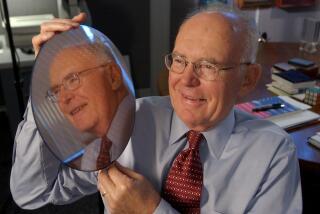Patent Question Has No Easy Answers : High technology: Gilbert Hyatt says he invented the computer chip. Until the dispute is settled in court, the microprocessor industry is likely to be unaffected.
- Share via
This week’s startling news that a previously unknown La Palma engineer was awarded a broad U.S. patent for microprocessor technology has reopened the question of who actually invented the “computer on a chip”--arguably one of the most important devices created in decades.
The answer, on which a market valued last year at $7 billion potentially hinges, won’t be easy and won’t come quickly, patent attorneys, semiconductor company officials and market analysts said Wednesday.
And, they added, until the answer is determined--probably after legal wrangling that could take years--the worldwide microprocessor industry is likely to be unaffected by engineer Gilbert Hyatt’s startling patent victory.
“Semiconductor manufacturers aren’t very likely to volunteer to begin paying Hyatt royalties on this invention without scrutinizing his claims very carefully,” said Gary Hecker, a Los Angeles patent attorney.
Semiconductor makers Intel Corp. and Texas Instruments, whose engineers are believed to be the first to invent the microprocessor, said Wednesday that they were reviewing the Hyatt patent papers and would not comment. Other semiconductor makers had similar responses.
Hecker said if Hyatt’s patent is ultimately found to be valid, significant and enforceable, he could stand to reap significant royalty payments.
Hyatt, a 52-year-old self-employed engineer, rocked the semiconductor industry earlier this week by announcing that, after a 20-year battle, he received in July a broad U.S. patent for the technology to create microprocessor devices.
Estimates of the potential value of Hyatt’s patent vary widely.
Industry analysts say standard nonexclusive licensing fees are about 3% of a product’s value. Based on last year’s sales, that could generate as much as $210 million if the patent’s extremely broad claims are fully upheld.
Even at the exceedingly modest licensing fee of 0.25%--which one analyst suggested Hyatt could possibly charge without raising much industry ire--royalty payments could reach $17.5 million based on last year’s sales levels.
Hyatt isn’t talking publicly about the fees he might want, and attorneys said any such talk is probably premature given the uncertain fate of his claims.
Attorneys say two critical issues must be settled before the extent of Hyatt’s patent claims can be resolved. First, what devices does the patent actually cover? And second, during the 20-year patent review process, when did Hyatt actually file some of the claims he is making about his invention?
Experts who have reviewed the Hyatt patent say its claims cast a wide net across the electronics industry. Potentially, the experts say, any microprocessor-based product--a category that covers VCRs, automobiles, personal computers, telephones and thousands of other everyday devices--could be covered by the patent.
However, some who have reviewed the patent say it leaves unanswered the question of whether Hyatt’s invention covers only a small variety of microprocessor devices with built-in data memory storage, or whether it also includes the more prevalent devices with separate microprocessors--the “brains” that control the activities of machines--as well as memory components.
Stuart Lubitz, a Los Angeles patent attorney who once worked with Hyatt and has reviewed the patent, said Hyatt’s claims “stretch the imagination.
“We’re talking about someone who is claiming to have patented something he would liked to have had, something that would have been nice to create,” Lubitz said. “This is what we call the classic ‘paper patent.’ ”
The second issue to be resolved, experts say, is the extent to which Hyatt changed his original patent application to cover new technology that might not have been available when he made his original filing in December, 1970.
According to several patent attorneys, a patent holder must be able to offer clear instructions for making the device he claims to have invented, although he is not required to construct it.
Although no one contends Hyatt made all the devices potentially covered by the patent, attorneys say there are still strong questions as to whether Hyatt provided required instructions before other patent applications covering similar devices were filed.
The issue arises because during the course of his 20-year battle, Hyatt filed at least seven applications for the patent, several of them after other key patents were issued.
“You’ve got to ask whether the technology was really in existence to make the device he claims when he filed the patent originally,” Lubitz said. “If it wasn’t, and someone else’s patent covered that technology first, then Hyatt’s patent might be worthless.”






